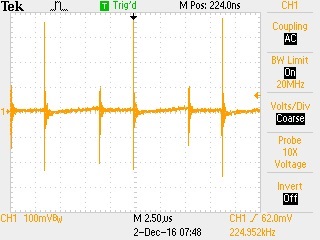Hi,
I experience some problems with the TPS40210 regarding the overcurrent shutdown. The problem is very similar to that posted by Thomas Schmit on Apr. 30, 2013 "TPS40210 Current Output Too Low / Early Overcurrent Shutdown".
My circuit works as a current source and therefore I mainly used the design example of the TPS40210 data sheet on page 32 "35 V LED driver" with some modification to meet my requirements on input / output voltage and output current. Here is the schematic
The problem is that I cannot reach the required output voltage. Using a modifiable load (resistor) I can just reach about 115 V. Up to that point everything works well and I get my required output current of 0.8 A. But when I further increase the load resistor the converter enters the hiccup mode.
When I decrease the output current to 0.6 A (by changing R11 to 1R1) I can increase the load resistor up to an output voltage of approx. 160 V. But then again the converter shuts down. In both cases the input current reaches almost 2 A. But with R10 = 25 mOhm a peak current of up to 6 A should be possible before the converter shuts down.
I already tried to decrease the current sense resistor to 19 mOhm but unfortunately with no effect at all. When I measure the ISNS pin with an oscilloscope I can see that the voltage just reaches about 80 mV which is far away from the shutdown threshold. Though the voltage spikes with every MOSFET switching make me suspicious and I wonder whether the problem could be related to that. Here is the screenshot:
On the other hand these spikes are there with more or less the same level also in situation where the converters works well.
I really appreciate any hints or recommendations.
Thanks so far
Thomas






